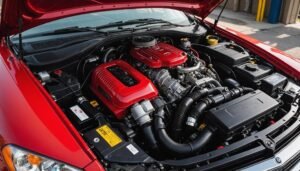It’s a coincidence that just as technology advances, so do the speeds of Formula 1 race cars. You’re probably aware that these high-performance machines can exceed 200 miles per hour, but there’s so much more to their speed. From powerful engines to cutting-edge aerodynamics, each element plays a vital role. Curious how these components work together to achieve remarkable feats on the track? Let’s explore the intricate details behind the staggering velocities of F1 cars.
Key Takeaways
- Formula 1 cars can exceed speeds of 200 miles per hour, reaching approximately 350 km/h at maximum performance.
- The fastest recorded F1 car, the Ferrari F2004, achieved a top speed of 413 km/h (256 mph) in 2005.
- Current F1 engines produce around 1000 horsepower, contributing significantly to acceleration and top speed capabilities.
- Top-tier F1 cars, like the Mercedes W11, frequently surpass 360 km/h (223 mph) during races, showcasing their speed potential.
- Acceleration rates allow F1 cars to go from 0 to 100 km/h in just 2.6 seconds, emphasizing their quick speed dynamics.
The Basics of Formula 1 Speed

When you think about the speed of a Formula 1 race car, what comes to mind? You might picture mind-boggling velocities, often exceeding 200 miles per hour. But speed in F1 isn’t just about how fast a car can go in a straight line; it’s about precision, aerodynamics, and technology. Formula 1 cars are engineered for peak performance on a variety of circuits, from tight street courses to expansive tracks. The use of advanced materials and state-of-the-art designs helps minimize drag while maximizing downforce. Every aspect, from tire choice to wing design, impacts speed and handling. You’ll notice that during qualifying, teams aim for the fastest lap, using softer tires that grip the track better. Ultimately, understanding F1 speed requires recognizing the delicate balance between raw power and the intricacies of car dynamics, creating an exhilarating experience both for drivers and fans alike.
Acceleration Rates of F1 Cars

Though you might think speed is the ultimate measure of a Formula 1 car’s performance, acceleration often steals the show. The ability to go from 0 to 100 km/h in just a few seconds gives F1 cars a competitive edge on the track. Let’s break down some impressive statistics of acceleration rates for these machines:
| Stage | Time (seconds) |
|---|---|
| 0 – 100 | 2.6 |
| 0 – 200 | 4.2 |
| 0 – 300 | 9.0 |
| 0 – 400 | 18.0 |
| Top Speed (approx.) | 350 km/h |
These figures show how essential acceleration is, especially in tight corners and during overtakes. When you’re driving alongside the competition, every millisecond counts, and a car’s acceleration can be the difference between victory and defeat.
Maximum Speed Achievements

Acceleration sets the stage for exciting racing, but the pinnacle of speed in Formula 1 truly captivates fans and competitors alike. The maximum speed achievements in F1 are remarkable, showcasing engineering excellence and driving prowess. You might be surprised by these key milestones:
The thrill of speed in Formula 1 captivates all, highlighting remarkable milestones in engineering and driving talent.
- Ferrari F2004 – Recorded a stunning 413 km/h (256 mph) during a test run in 2005.
- Honda RA106 – Achieved a top speed of 400 km/h (248 mph) in 2006, a remarkable feat at the time.
- Mercedes W11 – Showcased impressive runs, often exceeding 360 km/h (223 mph) during competitive races in 2020.
- Max Verstappen’s RB16 – Notable for crossing 360 km/h (223 mph) at the 2020 Italian Grand Prix, cementing his skills.
These incredible speeds continue to inspire improvements in technology and driver performance, pushing the limits of what’s possible on the track.
The Role of Aerodynamics
While speed captures attention, the role of aerodynamics is equally essential in defining a Formula 1 car’s performance on the track. You might be surprised to learn that how air flows around the car can considerably impact its speed and handling. The design of the car—shapes, wings, and bodywork—works to reduce drag and increase downforce.
Downforce pulls the car toward the track, improving tire grip, especially in corners. You’ll notice that at high speeds, a well-aerodynamic car accelerates faster and maintains stability.
Teams employ advanced simulations and wind tunnel testing to refine these designs, considering everything from airflow separation to vortex management. This meticulous attention to aerodynamic detail allows cars to slice through the air more efficiently. As you watch a race, consider how essential these invisible forces are in determining which driver crosses the finish line first!
Engine Power and Performance
When it comes to Formula 1 racing, the engine’s power and performance play a vital role in how fast cars can go. These finely-tuned machines rely on advanced engineering to deliver outstanding performance on the track. Here’s what contributes to their incredible power:
In Formula 1, advanced engineering drives engine power and performance, crucial for unlocking astonishing speeds on the track.
- Engine Configuration: Most F1 cars use a turbocharged V6 engine, providing a balance between power and efficiency.
- Hybrid Technology: The integration of electric motors allows for additional horsepower and better energy management during races.
- Battery Capacity: Enhanced energy recovery systems recharge faster, offering bursts of speed when needed.
- Power Output: Current engines can produce around 1000 horsepower, giving drivers the ability to accelerate rapidly and maintain high speeds.
Understanding these factors highlights why engine power and performance are essential for achieving top speeds in Formula 1. You can appreciate how these elements come together to create the thrilling spectacle of racing.
Tire Technology and Grip
The effectiveness of tire technology greatly influences how fast a Formula 1 car can navigate the track, as grip plays an essential role in maintaining control during high-speed turns and rapid acceleration. Modern F1 tires are engineered with advanced compounds and tread designs, optimized for various conditions. When you take a corner, those tires must grip the asphalt, allowing you to push the limits without losing control.
Different tire types, like soft and hard compounds, offer varying levels of grip and durability. The softer compounds provide better grip but wear out faster, while harder tires last longer but sacrifice some traction. Understanding this balance is vital for strategy—knowing when to pit and which tires to choose can make or break a race. So, as you watch those cars zoom by, realize it’s the intricate technology behind the tires that keeps them glued to the track, enabling breathtaking speeds and thrilling performances.
Track Conditions and Their Impact
Understanding tire technology provides a strong foundation for grasping how track conditions greatly influence a Formula 1 race. The relationship between track surface and tire composition is essential; both can make or break your lap times. Here are four key factors that illustrate how track conditions impact performance:
The interplay between tire technology and track conditions is crucial for optimizing lap times in Formula 1 racing.
- Temperature: Hot surfaces increase tire grip, while cold conditions lead to reduced traction.
- Weather: Rain or moisture changes how tires perform, often necessitating a switch to intermediate or wet tires.
- Surface Characteristics: A smooth track offers better grip compared to a rough or uneven surface, affecting lap speed.
- Rubber Build-Up: As tires wear during a race, rubber builds up on the track, enhancing grip but also altering the racing line.
Understanding these aspects helps you appreciate the strategies teams employ to adapt to ever-changing conditions on the circuit.
Comparison With Other Racing Formats
While Formula 1 racing stands out for its speed and technology, comparing it to other racing formats reveals intriguing differences in performance and strategy. Take NASCAR, for example. It prioritizes close-quarters racing on oval tracks, where high speeds are common but cornering strategies play an essential role. Here, drivers rely on drafting and pit stop strategies, as the emphasis shifts from outright speed to tactical racing.
In contrast, endurance racing, like the 24 Hours of Le Mans, focuses on sustainability and team collaboration. The speeds may not rival F1, but the challenge lies in maintaining performance over long durations with multiple drivers.
Lastly, rally racing showcases agility and adaptability as drivers tackle varied terrains at speed. Each format brings its unique pace and tactics, highlighting that racing isn’t just about speed; it’s about how that speed is mastered in diverse contexts. Understanding these nuances adds depth to your appreciation of motorsport as a whole.
Notable Speed Records in F1 History
In the world of motorsport, Formula 1 holds a prestigious place not only for its thrilling races but also for its remarkable speed records. You may be surprised to learn about these astonishing achievements that showcase the engineering prowess and driver skill within the sport. Here are four notable speed records in F1 history:
- Fastest Lap: Michael Schumacher set the record at 1:13.556 during the 2004 Italian Grand Prix in a Ferrari.
- Top Speed: The astonishing 372.5 km/h (231.5 mph) was recorded by Valtteri Bottas at the 2016 Mexican Grand Prix.
- Fastest Race Average Speed: Kimi Räikkönen achieved an average speed of 247.587 km/h (153.842 mph) during the 2005 Italian Grand Prix.
- First to 200 mph: Nigel Mansell was the first driver to exceed 200 mph in a Formula 1 car in 1992.
These records not only excite fans but also push the boundaries of automotive technology.
The Future of Speed in Formula 1
As technology continues to evolve, the future of speed in Formula 1 looks more thrilling than ever. You can expect advancements in aerodynamics, hybrid technology, and tire performance to push boundaries further. Innovations like active suspension systems and advanced materials will improve grip and reduce weight, allowing cars to navigate corners at unprecedented speeds.
Additionally, the integration of artificial intelligence and data analytics will provide engineers with real-time insights, enabling better decision-making during races. You’ll also see a focus on sustainability, with hybrid engines evolving to deliver maximum power while minimizing environmental impact.
The quest for speed isn’t just about raw power; it’s also about strategy and teamwork. As F1 teams continue to adapt and innovate, you’ll witness a new era of racing where every millisecond counts. Get ready for an exhilarating future that combines speed, technology, and eco-friendliness in a thrilling package.
Frequently Asked Questions
How Do F1 Race Car Speeds Vary by Track Layout?
F1 race car speeds don’t just glance off the track; they soar and plummet like a roller coaster! You’ll notice that speeds vary dramatically with track layout. Tight turns and slow corners can bring those magnificent machines down to crawling speeds, while long straights release their raw power, catapulting them into heart-stopping velocity. Each track’s unique combination of curves and straights demands different strategies, challenging you to appreciate the art of speed.
What Safety Measures Are in Place for High Speeds?
In Formula 1, safety measures for high speeds include advanced car design with crash structures, halo devices to protect drivers’ heads, and fire-resistant suits. You’ll notice tracks have run-off areas and barriers to absorb impact. Teams also utilize extensive data analysis to optimize performance while maintaining control. Regular inspections guarantee cars meet safety standards, and drivers undergo fitness and mental training to handle the physical demands of high-speed racing.
How Do Driver Skill Levels Influence Speed?
Driver skill levels are the fuel that drives speed in Formula 1. Imagine a symphony—each driver plays their instrument, and the most seasoned conductors create harmonious, lightning-fast laps. Your precision in cornering, braking, and accelerating determines how you harness that raw power. A skilled driver dances with the car, feeling its every instinct, while a novice fumbles, losing precious time. In F1, mastery transforms speed into poetry on the track.
Are There Speed Limits on Pit Road During Races?
Yes, there are speed limits on pit road during races. You’ll usually see a limit of around 60 km/h (37 mph) for safety reasons, ensuring that team members and equipment are protected as cars enter and exit the pit box. If you exceed this limit, you risk penalties, including drive-throughs or time penalties. So, it’s essential to keep your speed in check while maneuvering the pit stop to avoid costly mistakes.
How Often Do Speed Records Get Broken in F1?
Speed records in F1 get broken quite frequently, with approximately one or two significant records shattered each season. For example, Lewis Hamilton set a record time of 1:31.304 during the 2020 British Grand Prix, illustrating the ever-evolving nature of technology and skill in the sport. Each season introduces new regulations and advancements, pushing drivers and teams to find that extra edge, ensuring fans can always expect thrilling records to chase.













